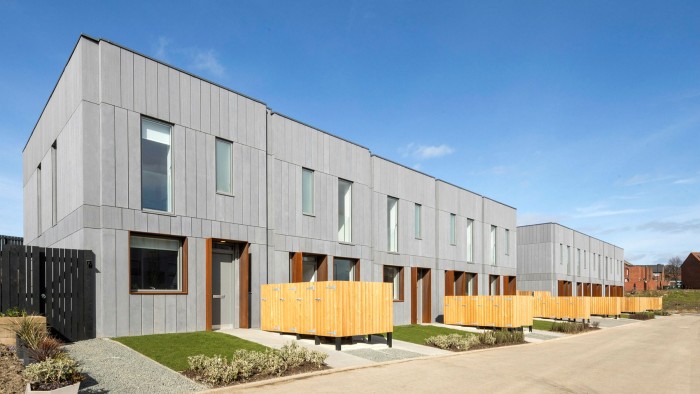Why modular housing is stubbornly small-scale

Roula Khalaf, Editor of the FT, selects her favourite stories in this weekly newsletter.
Knocking down buildings carries a heavy environmental cost. In the UK, for example, more than 50,000 buildings are demolished a year — and that destruction is one of the reasons why the construction industry is responsible for 10 per cent of UK carbon emissions, according to the Architects’ Journal Retro First campaign. It is calling for buildings to be retrofitted as an alternative to demolition.
By designing buildings to be easily reconfigurable when their purpose changes, the need to demolish and rebuild would be reduced. A townhouse could be extended with bolt-on bedrooms as a family grows. Or, with minimal adjustments, student accommodation blocks might be transformed into sheltered housing for older people.
Modern modular building techniques can enable all this, and allow developers to make flexible units in factories before transporting them for assembly on-site. In addition, proponents say modular units can be constructed like giant Lego bricks, often within weeks, with less waste and at lower cost than traditional buildings. And they are often of high-quality design, too.
Yet there is no mass market for modular structures. In the US, just 3 per cent of single-family homes built in 2020 were modular, according to the National Association of Home Builders.

A lingering stigma, lack of vision and vested interests are the main obstacles, says Avi Friedman, a professor of architecture at McGill University in Canada and an expert on modular housing. “Most houses are manufactured in the way they were 100 years ago — on-site, conventionally. We send raw materials that are adjusted to the site conditions, then they are chopped and cut to fit. That’s a tremendous amount of waste.”
Friedman points out that modular housing is not new. In its modern form, more than 150,000 prefabricated houses were built in the UK after the second world war, for example, because of the housing shortage, and with some success. But they remain associated with lack of choice and short-term measures. “They were ugly, bulky, and not attractive,” says Friedman. “That has changed today.”
A prime example of attractive modern modularity is the award-winning Marmalade Lane housing development in Cambridge, in the east of England, by Mole Architects. Some 42 homes were built with prefabricated timber frame panels and completed in 2018.
“But generally, the homebuilding industry did not attempt to shed or reduce that stigma,” says Friedman.
As well as the image problem, “boring realities”, such as volume and procurement, are obstacles to modular housing in the UK, says architect Tom Lewith. “Efficiencies come from repeat orders, as with any factory. A lot of manufacturers [of modular housing] don’t have the order numbers.”
According to Lewith, that is because large-scale housebuilders are reluctant to deliver hundreds of houses at a time, partly because of market pressures: “If you deliver 200 in one go, you might affect your own margin.”
Lewith is director of UK firm TDO Architecture, which worked with two developers, Places for People and Urban Splash on FAB House, a terrace of 10 private modular houses in North Shields in the north-east of England.
The development was built in 2018 at The Plateau, Smith’s Dock, the derelict site of a former shipyard for 30 years. Some practical problems were minimised, says Lewith, because Urban Splash part-owns one of the UK’s few modular factories, where the houses were built. Another is owned by L&G group.
Despite the challenges, some modular specialists are optimistic. Netherlands-based Finch Buildings, which specialises in small-scale modular timber structures, says pandemic-related labour and supply shortages have worked in its favour. “Building in a factory makes more and more sense,” says founder and director Jurrian Knijtijzer.
Finch recently finished a timber-clad, modular, reconfigurable complex of 62 apartments in Monnickendam, north of Amsterdam, two-thirds of which are social housing. Construction took seven months from foundations to completion. “The normal building time would be one-and-a-half years,” he says.
But, like Friedman, he says modular buildings suffer a perception problem: “‘Modular’ still sounds temporary. People think it lacks quality, or that there might be something wrong with it.” The Monnickendam development was purposely designed to look like a series of low-rise terrace town houses, and less uniform than previous developments. “That was an important step,” he says.

Some more ambitious projects have run into different problems. Julien De Smedt, founder and director of Copenhagen-based JDS Architects, describes the difficulties he faced in trying to build modular structures made from recycled plastic in Africa and Asia, in partnership with the UN.
De Smedt’s modular system offers endless configuration and the material, plastic, is “very resistant when compacted, it’s really strong”, he says. “But the techniques require multiple local partners to produce.” That is because De Smedt hopes to recycle plastic that has been dumped locally. He hoped to build the first development by early 2022, but estimates that it will now be the end of the year before work begins.
“We see it as [having the] potential to create affordable housing,” he says. “We put together a modular system that allows us to create elements of all kinds of typologies — not only housing but also schools and even hospitals.”
Image problems combined with lack of an ecosystem means modular construction is most often completed on a small scale by progressive operators. Friedman believes its potential is limitless, but says architects need more support from big housebuilders, developers and policymakers to make it work.
For the moment, however, “the industry is stacked against innovation”.
Comments